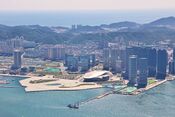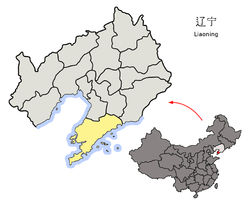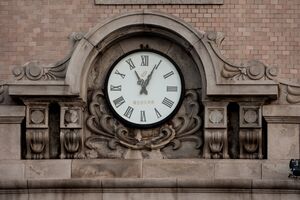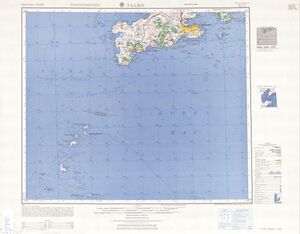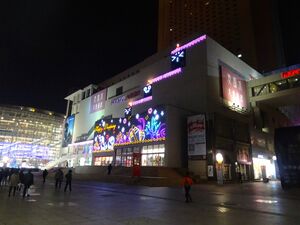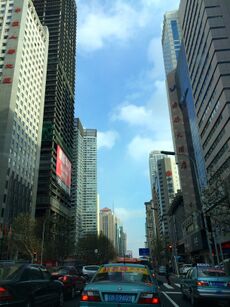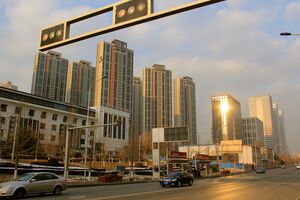داليان
| ||||||||||||||||||||||||||||||||||||||||||||||||||||||||||||||||||||||||||||||||||||||||||||
| ||||||||||||||||||||||||||||||||||||||||||||||||||||||||||||||||||||||||||||||||||||||||||||
| ||||||||||||||||||||||||||||||||||||||||||||||||||||||||||||||||||||||||||||||||||||||||||||
داليان (simplified Chinese: 大连; traditional Chinese: 大連; pinyin: Dàlián; نطق المندرينية: [tâljɛ̌n]؛ إنگليزية: Dalian)، هي مدينة ومنطقة حضرية كبيرة تقع شمال شرقي الصين، وقاعدة صناعية هامة. إداريا تتبع مقاطعة لياونينگ. بلغ عدد سكانها حوالي 5.500.000 نسمة (عام 2001).
اليوم، كمركز للأنشطة المالية والشحن واللوجستيات في شمال شرق آسيا، لداليان تاريخ بارز لكونها قد استخدمت من قبل القوى الأجنبية من أجل موانيها. اشتهرت داليان في السابق بإسم دالني[3] (روسية: Дальний؛ Dal'nii) ودايرن (يابانية: 大連). ومع ذلك، فالشهرة الأكبر لها هي پورت أرثر (روسية: Порт-Артур؛ ميناء أرثر) وريوجون (يابانية: 旅順) المشتقة من ميناء أرثر الأصلي، مديرية لوشونكو الحالي بالمدينة.
وفي 2016، احتلت داليان الترتيب 48 في مؤشر المراكز المالية العالمية، والمدن الصين الأخرى المدرجة على المؤشر هي هونگ كونگ، شنغهاي، شنژن، بكين وچینگداو.[4] في 2012، احتلت داليان الترتيب 82 على مؤشر التنافسية العالمية للمدن.[5] في 2006، أطلقت عليها الصين اليومية المدينة الأكثر ملاءمة للحياة في الصين.[6]
تعتبر اليوم من المناطق الأكثر تقدما في الصين. تتميز مدينة داليان بالظروف المينائية الممتازة، فهي النافذة الرئيسية للتجارة في مناطق الشمال الشرقي مع دول شمال شرقي آسيا، والممر الرئيسي لنقل المواد والبضائع. تتميز المدينة بهندسة مبانيها والإعتناء الحدائق العامة والمساحات الخضراء؛ لها بنية تحتية ومرافق حديثة، تجلب إليها العديد من المشاريع التكنولوجية والصناعية، وتعمل السلطات على توفير بيئة استثمار مريحة لجلب المزيد من المستثمرين. كانت داليان أول مدينة صينية أقامت منطقة تنمية اقتصادية وتكنولوجية في الصين، كما تتواجد فيها منطقة "منتزه العلوم والتكنولوجيا العالية"، ويقام فيها المهرجان الدولي للأزياء سنويا بالإضافة إلى غير ذلك من النشاطات الموجهة للخارج. تخطط داليان أن تصبح مركزا تجاريا وماليا وسياحيا ومركز معلومات وهمزة وصل للمواصلات في منطقة شمال شرقي آسيا في المستقبل.
داليان هي أيضاً واحدة من أعلى 50 مدينة علوم في العالم حسب البحث العلمي كما يرصده مؤشر نيتشر، بترتيب 49 على العالم في عام 2022.[7] المدينة هي مقر للعديد من الجامعات الرئيسية، خصوصاً جامعة داليان للتكنولوجيا و جامعة داليان البحرية، وهما من الجامعات الراقية في الصين في المشروع 211، و معهد داليان للفيزياء الكيميائية التابع لأكاديمية العلوم الصينية.
أصل الاسم
داليان المعاصرة تنحدر من چينگنيوا (Chinese: 青泥洼; pinyin: Qīngníwā; lit. 'cyan mud swamp') أو چينگنيواچياو (Chinese: 青泥洼桥; pinyin: Qīngníwāqiáo; lit. 'جسر على مستنقع من الطين السماوي')، قرية صيادين صغيرة. شيدت الامبراطورية الروسية بلدة تجارية من أجل كوانتونگ، الأرض المستأجرة بعد أن استولوا عليها في 1898 وسمّوها "دالني" (روسية: Дальний, romanized: Dal'nii - "النائية" أو "البعيدة"، في إشارة إلى موقع البلدة،[8] وتُكتَب Chinese: 达里尼; pinyin: Dálǐní) من 1898 إلى 1905. بعد الحرب الروسية اليابانية في 1904–1905، احتلت اليابان "كوانتونگ، الأرض المستأجرة" وغيروا اسم المدينة إلى دايرن Dairen (يابانية: 大連/だいれん)[8] اشتقاقاً من الاسم الصيني لـخليج داليان (simplified Chinese: 大连湾; traditional Chinese: 大連灣; pinyin: Dàlián Wān) - وهو اسم مستخدم على الأقل منذ 1879. المصادر باللغة الإنگليزية سمّت المدينة "Dairen" في تلك الفترة (1905-1945)، من اليابانية.
في داليان عام 1950، عادت المدينة مرة أخرى لسيطرة الصينن واندمجت مع البلدة القريبة المسماة لوشون (Chinese: 旅顺) (سابقاً "ريوجون" وقبل ذلك، "پورت آرثر") ليشكلا مدينة لودا[8] (Chinese: 旅大; pinyin: Lǚdà)، وهو الاسم (المشكـَّل من أول مقطع من كلٍ من المدينتين) وكان في المعتاد يُكتب لوتا بالإنگليزية في تلك الفترة. وفي 1981، مرة أخرى قام مجلس الدولة الصيني بتغيير اسم المدينة، من لودا إلى "داليان" (simplified Chinese: 大连; traditional Chinese: 大連; pinyin: Dàlián، باستخدام نفس الحروف الصينية كاليابانية دايرن)، بدءاً من 5 مارس 1981.[8]
التاريخ
التاريخ القديم
In the Qin and Han periods (221 BC–AD 220), the Chinese state expanded its territories into northern Korea through the Dalian region, then under the jurisdiction of Liaodong county.[8] During the Sixteen Kingdoms era (3rd through 5th centuries), the Korean kingdom of Goguryeo controlled this region. In the early Tang Dynasty (618–907), the Dalian region formed part of Andong Prefecture in Jili state; during the Liao Dynasty (916–1125), it was part of Dong Jing Tong Liaoyang county. Dalian was named Sanshan in the period of Wei Jin (220–420), San Shanpu in the Tang Dynasty (618–907), Sanshan Seaport in the Ming Dynasty (1368–1644), and Qingniwakou during the Qing Dynasty (1644–1911).
أسرة تشينگ
In the 1880s, Jinzhou, the north of downtown Dalian, now Jinzhou District, was a walled town and a center for political intrigue and economic activity. The Qing government built bridges and heavily fortified the peninsula. Mining camps on the northern coast of Dalian Bay became the small town of Qingniwa (青泥洼) or Qingniwaqiao (青泥洼桥), near what became the downtown core of modern-day Dalian.
الاحتلال البريطاني ثم الروسي ثم الياباني
 مقالات مفصلة: داليان الروسية
مقالات مفصلة: داليان الروسية- كوانتونگ، الأرض المستأجرة
أطلق البريطانيون على المدينة اسم پورت آرثر حين استخدموها قاعدة لمحاربة الصين عام 1857. ثم أصبحت المدينة فيما بعد قاعدة بحرية صينية. وقد أخذت اليابان هذه المدينة من الروس عام 1905 بعد أن انتصرت في الحرب الروسية اليابانية. وبعد نهاية الحرب العالمية الثانية عام 1945، اتفقت الصين والاتحاد السوفيتي (سابقًا) على اعتبار هذا الميناء قاعدة بحرية مشتركة. وفي تلك الفترة دمجت لوشون في مدينة داليان وأصبحت المدينتان تعرفان باسم لودا. وفي 1955، أعاد الاتحاد السوڤيتي المدينة إلى السلطة الصينية.
The British briefly occupied Qingniwa during the Second Opium War in 1858,[9] but returned it to Chinese (Qing) control in 1860. Port Arthur at the tip of the Liaodong Peninsula took its English name from Royal Navy Lieutenant William Arthur, while the Chinese called it Lüshun. Although China heavily fortified the area, in which it allowed trade with foreigners, in the First Sino-Japanese War Japan swiftly overcame those defenses[بحاجة لمصدر] on 21 November 1894 in the Battle of Lüshunkou, immediately committing the Port Arthur massacre. In April 1895 China conceded defeat in the First Sino-Japanese War, ceding Liaodong Peninsula, Taiwan and Penghu, and making many other concessions in the Treaty of Shimonoseki (17 April 1895).

In the Triple Intervention of 23 April 1895, Russia, France and Germany forced Japan to return the Liaodong Peninsula to China, despite the treaty's terms; instead the Russian Empire coerced a lease of the peninsula from the Qing Dynasty in 1898. Russia had a particular interest in the region of the peninsula as one of the few areas in the region that had the potential to develop ice-free ports.[10] The Russians built a modern commercial port city, which they wanted to become the Paris of the Far East, and called it Dal'niy (روسية: Дальний).[11] Linked by 1902 with the Trans-Siberian Railway via the branch line Chinese Eastern Railway through Harbin, Dal'niy became Russia's primary port-city in Asia, and also served Western traders. Russia signed the Pavlov Agreement (1898) with China, which granted Russia a 25-year lease on Dalian and Lüshun and exclusive right to build a branch of the Chinese Eastern Railway—what would become from 1905 the Japanese-operated South Manchurian Railway.[12] Russia spent more than 10 million golden rubles (equivalent to 11.5 billion of today's rubles) building the new ice-free port city.[13]
Russia heavily fortified both Dalniy (Qingniwaqiao of Zhongshan District) and the Port Arthur naval base (Lüshunkou) before and after the Boxer Rebellion of 1899-1901. Missionaries and converts were killed[ممن؟] in the peninsula during the insurrection, although the massive massacres of ethnic Chinese Christians including Metrophanes, Chi Sung occurred at Harbin.[14] Western expeditionary forces suppressed the Boxers across the Yellow Sea in Shandong.
During the Russo-Japanese War of 1904-1905, the Liaodong Peninsula became a major battleground. Major-General Baron Anatoly Stoessel defended a besieged Port Arthur, for five months (August 1904 to January 1905), but the Japanese army, using long-distance fire, sank several Russian ships at the Port Arthur naval base in early December 1904. Admiral Eugene Alexeyeff was blamed[ممن؟] for splitting precious resources shipped 8,000 km (5,000 mi) across the single tracked Trans-Siberian Railway and Manchurian Railway between Dalniy and Port Arthur. After the Imperial Japanese Navy crippled the remaining Russian battleship Sevastopol in three weeks of constant attacks, and explosives detonated in tunnels destroyed Port Arthur's remaining defenses in the final days of 1904, Russia negotiated a ceasefire and surrendered Port Arthur in January 1905.[15]
The Treaty of Portsmouth (signed 5 September 1905) ceded Port Arthur to Japan, which set up the Kwantung Leased Territory or Guandongzhou (關東州), on roughly the southern half (Jinzhou District and south) of present-day Dalian. Japanese invested heavily in the region, which became the main trading port between Manchuria and Japan. Japan leased the area from Manchukuo after establishing that puppet state in 1932. In 1937, as the Second Sino-Japanese War began, Japan enlarged and modernized the trade zone as two cities: the northern Dairen (Dalian) and the southern Ryojun (Lüshun or Port Arthur).
بعد الحرب العالمية الثانية
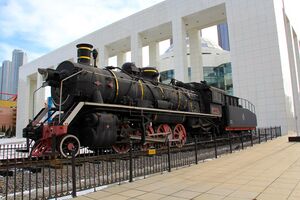
With the unconditional surrender of Japan in August–September 1945, Dairen passed to the Soviets, whose Manchurian Strategic Offensive Operation had liberated the city on 22 August 1945. The Soviets and Chinese Communists cooperated to develop the city, relatively undamaged during the war,[8] especially its industrial infrastructure and the port. The Soviet government rented the port and in 1945 the first Chinese Communist mayor of the new Lüda Administrative Office (旅大行政公署) was appointed.[بحاجة لمصدر]
In 1950 the USSR presented the city to the Chinese Communist government without any compensation. Dalian and Lüshun (former Port Arthur) merged as Lüda on 1 December 1950. From 12 March 1953 to 1 August 1954 it was a direct-controlled municipality and not part of Liaoning. Soviet troops left the city in 1955.[8] After the Soviets left, the PRC made Lüda a major shipbuilding center.
In 1981 the city was renamed Dalian, with Lüshunkou becoming a constituent district.[8] In 1984 the Chinese Government designated the city a Special Economic Zone. At the time, Dalian was China's largest foreign-trade port.[16]
1990 إلى 2010
The city was upgraded from a prefecture-level city to a sub-provincial city in May 1994, with no change in its administrative subdivisions. In the 1990s the city benefited from the attention of Bo Xilai (later Party secretary of Chongqing). Bo served both as the mayor of the city and as one of the major leaders in the province; among other things, he banned motorcycles and planted large, lush parks in the city's many traffic circles. He also preserved much of Dalian's Japanese and Russian architectural heritage. He also worked as former Minister of Commerce of China (in office: 2004-2007).
In 2008 about 1,000 people protested and blocked traffic as a response to the 2008 Tibetan anti-Chinese protests,[17] and forced the temporary closure of the local Carrefour store.[18]
Since 2007 Dalian has hosted the Annual Meeting of the New Champions ("Summer Davos"), organized by the World Economic Forum, in alternating years with Tianjin.[19] The venue for the forum is the Dalian International Conference Center in Donggang CBD. In 2008 about 1,000 people protested and blocked traffic as a response to the 2008 Tibetan anti-Chinese protests,[20] and forced the temporary closure of the local Carrefour store.[21]
بعد 2010

In 2010 one of the worst recorded oil-spills in China's history occurred in Dalian. The Dalian PX protest occurred on 14 August 2011. In June 2014, China's tenth state-level new area, the Dalian Jinpu New Area was officially established. On 5 August 2016, the Dalian huabiao incident occurred. A huabiao in the center of Xinghai Square was demolished, which was believed to be out of political reasons related to the downfall of Chinese politician Bo Xilai, who oversaw the construction of Xinghai Square and the central huabiao during his tenure as the mayor of Dalian. The site of the huabiao was later replaced with a musical fountain, the largest one in Northeast China.
الجغرافيا
| داليان | ||||||||||||||||||||||||||||||||||||||||||||||||||||||||||||
|---|---|---|---|---|---|---|---|---|---|---|---|---|---|---|---|---|---|---|---|---|---|---|---|---|---|---|---|---|---|---|---|---|---|---|---|---|---|---|---|---|---|---|---|---|---|---|---|---|---|---|---|---|---|---|---|---|---|---|---|---|
| جدول طقس (التفسير) | ||||||||||||||||||||||||||||||||||||||||||||||||||||||||||||
| ||||||||||||||||||||||||||||||||||||||||||||||||||||||||||||
| ||||||||||||||||||||||||||||||||||||||||||||||||||||||||||||

One of the most heavily developed industrial areas of China, Dalian municipal area today consists of Dalian proper and the smaller Lüshunkou (formerly Lüshun city, known in Western and Russian historic references as Port Arthur), about forty nautical miles (74 kilometers; 46 miles) farther along the Liaodong Peninsula. Historical references note that the Russian designed city of Dalniy (Alt. Dalney), on the south side of Dalian Bay was 40 kilometers (25 miles) from Port Arthur/Lüshun (known today as Lüshunkou or literally, Lüshun Port).
Dalian is located on Korea Bay north of the Yellow Sea and roughly in the middle of the Liaodong peninsula at its narrowest neck or isthmus. With a coastline of 1,906 km (1,184 mi), it governs the majority of the Liaodong Peninsula and about 260 surrounding islands and reefs. It is seated at south-south-west of the Yalu River, and its harbor entrance forms a sub-bay known as Dalian Bay.
الطقس
Dalian has a monsoon-influenced humid continental climate (Köppen Dwa), characterized by warm wet summers due to the East Asian monsoon, and cold, windy, dry winters that reflect the influence of the vast Siberian anticyclone. Except for winter, the city experiences a one-month seasonal lag due to its position on the Liaodong Peninsula. The monthly 24-hour average temperature ranges from −3.3 °C (26.1 °F) in January to 24.8 °C (76.6 °F) in August. Annual precipitation averages 580 millimeters (22.8 in) but is heavily concentrated in the summer months and can vary greatly from year to year. Due to the coastal location, the mean diurnal temperature variation annually is small, at 6.66 °C (12.0 °F). The monthly percent of possible sunshine ranges from 45% in July to 66% in March, with 2,625 hours of bright sunshine annually. The annual mean temperature is 11.6 °C (52.9 °F). Extremes since 1951 have ranged from −21.1 °C (−6 °F) on 4 January 1970 to 36.6 °C (98 °F) on 14 July 2015.[22]
| أخفClimate data for داليان (1991–2020 normals) | |||||||||||||
|---|---|---|---|---|---|---|---|---|---|---|---|---|---|
| Month | Jan | Feb | Mar | Apr | May | Jun | Jul | Aug | Sep | Oct | Nov | Dec | Year |
| Record high °C (°F) | 10.2 (50.4) |
14.2 (57.6) |
20.1 (68.2) |
28.5 (83.3) |
33.8 (92.8) |
35.6 (96.1) |
36.6 (97.9) |
34.4 (93.9) |
33.4 (92.1) |
28.2 (82.8) |
21.7 (71.1) |
14.4 (57.9) |
36.6 (97.9) |
| Mean daily maximum °C (°F) | 0.0 (32.0) |
2.5 (36.5) |
8.2 (46.8) |
15.1 (59.2) |
21.2 (70.2) |
24.8 (76.6) |
27.3 (81.1) |
27.9 (82.2) |
24.5 (76.1) |
17.8 (64.0) |
9.8 (49.6) |
2.9 (37.2) |
15.2 (59.3) |
| Daily mean °C (°F) | −3.3 (26.1) |
−0.9 (30.4) |
4.3 (39.7) |
10.9 (51.6) |
16.9 (62.4) |
20.9 (69.6) |
24.0 (75.2) |
24.8 (76.6) |
21.1 (70.0) |
14.3 (57.7) |
6.3 (43.3) |
−0.5 (31.1) |
11.6 (52.8) |
| Mean daily minimum °C (°F) | −6.0 (21.2) |
−3.7 (25.3) |
1.2 (34.2) |
7.4 (45.3) |
13.2 (55.8) |
17.8 (64.0) |
21.7 (71.1) |
22.3 (72.1) |
18.2 (64.8) |
11.2 (52.2) |
3.3 (37.9) |
−3.4 (25.9) |
8.6 (47.5) |
| Record low °C (°F) | −21.1 (−6.0) |
−17.1 (1.2) |
−15.3 (4.5) |
−4.2 (24.4) |
3.7 (38.7) |
10.5 (50.9) |
14.2 (57.6) |
14.5 (58.1) |
6.4 (43.5) |
−1.9 (28.6) |
−12.8 (9.0) |
−19.0 (−2.2) |
−21.1 (−6.0) |
| Average precipitation mm (inches) | 5.7 (0.22) |
8.1 (0.32) |
11.0 (0.43) |
34.2 (1.35) |
56.4 (2.22) |
71.4 (2.81) |
120.3 (4.74) |
172.0 (6.77) |
51.8 (2.04) |
37.6 (1.48) |
26.2 (1.03) |
9.5 (0.37) |
604.2 (23.78) |
| Average precipitation days (≥ 0.1 mm) | 2.8 | 2.9 | 3.0 | 5.8 | 6.6 | 8.2 | 10.1 | 9.2 | 5.5 | 5.9 | 5.3 | 3.8 | 69.1 |
| Average snowy days | 5.2 | 3.6 | 2.1 | 0.3 | 0.0 | 0.0 | 0.0 | 0.0 | 0.0 | 0.2 | 2.9 | 6.8 | 21.1 |
| Average relative humidity (%) | 56 | 57 | 53 | 54 | 60 | 73 | 82 | 80 | 69 | 62 | 60 | 58 | 64 |
| Mean monthly sunshine hours | 192.5 | 191.8 | 244.3 | 254.6 | 274.7 | 242.8 | 203.4 | 222.9 | 235.5 | 218.6 | 172.3 | 171.6 | 2٬625 |
| Percent possible sunshine | 63 | 63 | 66 | 64 | 62 | 55 | 45 | 53 | 64 | 64 | 58 | 59 | 60 |
| Source: China Meteorological Administration[22][23][24] | |||||||||||||
See or edit raw graph data.
الإدارة
Dalian is the second largest city of Liaoning province, after Shenyang, the provincial capital. The city of Dalian is governed by the Dalian Municipal People's Government.
حكومة البلدية
The municipal government is located in the main building on the north side of People's Square on Zhongshan Road, originally built as the Administrative Office of Kwantung Leased Territory, and other buildings in downtown Dalian. There are the Commerce, Foreign Economy & Trade, Health, Information Industry, Police, Religion, Science & Technology, Transportation and other city-level bureaus, which work closely with the corresponding agencies at the district level.
There are, in addition, 4 national leading open zones (对外开放先导区):
- The Development Zone (开发区)
- The Free Trade Zone (保税区)
- The Hi-Tech Industrial Zone (高新技术产业园区)
- The Jinshitan ("Golden Pebble Beach") National Holiday Resort (金石滩国家旅游度假区)
التقسيمات الادارية
(انظر التقسيمات الإدارية في جمهورية الصين الشعبية)
The city administers 7 districts, 2 county-level cities, and 1 الناحية:
- There are 92 sub-districts and 69 towns and townships.[25]
- Zhongshan, Xigang, Shahekou and Ganjingzi Districts make up the urban core. Changhai County is made up entirely of islands east of the peninsula.
| الخريطة | ||||||||
|---|---|---|---|---|---|---|---|---|
| الاسم | بالصينية | المعنى | المندرينية الفصحى | مندرينية جياولياو | التعداد (تقدير 2015) |
المساحة (كم²) | الكثافة (/كم²) | |
| المدينة نفسها | ||||||||
| Zhongshan District | 中山区 | على اسم Sun Yat-sen (بلا سبب تاريخي) | Zhōngshān Qū | Zhong2 San4 Qu4 | 360,722 | 40.1 | 8,996 | |
| Xigang District | 西岗区 | West Sentry (أطلقه اليابانيون) | Xīgǎng Qū | Xi4 Gang4 Qu4 | 293,316 | 23.94 | 12,252 | |
| Shahekou District | 沙河口区 | Sand River Estuary | Shāhékǒu Qū | Sa4 He2 Kou3 Qu4 | 648,719 | 34.71 | 18,690 | |
| Ganjingzi District | 甘井子区 | Sweet Well (طبقا لأسطورة) | Gānjǐngzi Qū | Gan4 Jinge3 Qu4 | 843,342 | 451.52 | 1,868 | |
| الضواحي | ||||||||
| Lüshunkou District | 旅顺口区 | Safe Travel Estuary (also named Port Arthur) | Lǚshùnkǒu Qū | Lv3 Sun4 Kou3 Qu4 | 221,356 | 512.15 | 432 | |
| Jinzhou District | 金州区 | Golden State (Named by Emperor Taizong of Tang | Jīnzhōu Qū | Jin4 Zhou0 Qu4 | 681,543 | 1,352.54 | 504 | |
| Pulandian District | 普兰店区 | Land of Brambles (Manchu) | Pǔlándiàn Qū | Pulan4 Dian4 Qu4 | 915,595 | 2,769.9 | 331 | |
| المدن الساتلة | ||||||||
| Wafangdian | 瓦房店市 | Land of Tile-roofed Houses | Wǎfángdiàn Shì | Wa4 Fang4 Dian4 Si4 | 997,830 | 3,576.4 | 279 | |
| Zhuanghe | 庄河市 | Zhuang River | Zhuānghé Shì | Zuang4 He0 Si4 | 901,182 | 3,655.7 | 247 | |
| الريف | ||||||||
| Changhai County | 长海县 | Long Sea (formerly named Elliot Islands) | Chánghǎi Xiàn | Chang2-hai Xian4 | 72,033 | 156.89 | 459 | |
لوشون
لوشون مدينة تقع بالقرب من حافة شبه جزيرة لياو دونگ شمالي الصين. تعد المدينة جزءًا من بلدية داليان. وكانت لوشون تدعى في السابق پورت آرثر. تنقسم لوشون إلى قسمين: المدينة الصينية القديمة، والمدينة الحديثة التي بناها الروس حين استولوا على المدينة في 1898.
الاقتصاد

The city has had a continuous annual double-digit percentage increase in GDP since 1992.[26] In 2014, the city's GDP registered a 5.8% increase, reaching RMB 765.56 billion, while per capita GDP hit RMB 109,939.[27] According to a nationwide appraisal by the National Bureau of Statistics, Dalian ranks eighth among Chinese cities in terms of overall strength.[26] The city's main industries include machine manufacturing, petrochemicals and oil refining, and electronics.[28]
الزراعة والبيئة المائية
Dalian was originally an agriculture and aquaculture-based area, which, after the opening of the ferry between Yantai and Lüshun during the early 20th century, began to be populated by the farmers and fishers of Shandong, across the Yellow Sea during the Chuang Guandong era.
الصناعات الثقيلة والخفيفة والتوزيع

Even before and during the Second Sino-Japanese War, the shipbuilding and locomotives industries were located in the city such as the companies which later became Dalian Shipbuilding Industry Company and Dalian Locomotive & Rolling Stock Works (DLoco). After the WWII, Dalian became an important center of the heavy and light industries, including companies such as Dalian Heavy Industry Co., Dalian Chemical Group, and Wafangdian Bearing Co.; and of the distribution industry, such as the Dashang Group.
Dalian Port is an important port for international trade. It has established trading and shipping links with more than 300 ports in 160 countries and regions of the world. There are over 100 international and domestic container shipping routes.[29] A harbor for oil tankers (the largest by tonnage in China),[29] at the terminus of an oil pipeline from the Daqing oilfields, was completed in 1976. Dalian is the 6th largest port in China;[30] and according to AAPA world port ranking data, Dalian is the 8th busiest port in the world by cargo tonnage in 2012, and the 12th busiest container port in the world by total number of TEUs handled in 2013.[31][32] Accordingly, Dalian is a major center for oil refineries, diesel engineering, and chemical production.
Also completed in 1993 is a newer port called Dayaowan Port (Chinese: 大窑湾港; pinyin: Dàyáowān Gǎng), on Dagushan (大孤山; Dàgūshān) Peninsula in the northern suburbs, specializing in import-export of mining and oil products. Together with the Dalian Railway Station, Dalian North Railway Station, Dalian International Airport and two major express roads to Shenyang (Shenda Expressway), Changchun (Changda Expressway), Harbin (Hada Expressway) in the north and to Dandong to the east, Dalian has been an important distribution center.[33]
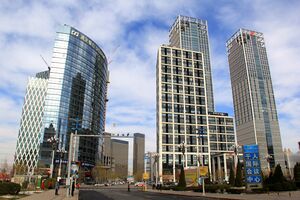
المناطق الصناعية
Dalian has been given many benefits by the Chinese government, including the title of "open-city" (1984), which allows it to receive considerable foreign investment (see Special Economic Zone). The Development Zone was established in Jinzhou District, to which many Japanese companies, such as Canon, Mitsubishi Electric, Nidec, Sanyo Electric and Toshiba, followed by South Korean, American and European companies (such as Pfizer). In 2007, Intel announced plans to build a semiconductor fabrication facility (commonly known as a fab) in the Development Zone, Dalian. It is Intel's first fab to be built at an entirely new site since 1992. The facility began operation in October 2010.[34] Dalian also houses auto-manufacturing plants for Chery,[35] Dongfeng Nissan Passenger Vehicle Company,[36] and BYD Automobile (a production base for BYD K9 electric buses).[37]
Other zones in the city include the Dalian Economic and Technological Development Zone, Dalian Export Processing Zone, Dalian Free Trade Zone, and Dalian Hi-Tech Industrial Zone.
الصناعات المالية وتكنولوجيا المعلومات
Dalian is the financial center of Northeast China. There are the Dalian branches of China's five major banks: Bank of China, Industrial & Commercial Bank of China, China Construction Bank, Bank of Communications, and Agricultural Bank of China. Dalian City Commercial Bank is now called Bank of Dalian, which among other things handles processing of the Dalian Mingzhu IC Card for public transportation. Bank of Dalian has opened branches in Beijing, Shanghai and Shenyang, among five other cities.[38]
Founded in 1993, Dalian Commodity Exchange (DCE) is the only futures exchange in Northeast China. The futures industry leaped forward in its development. Among its 19 listed futures products approved by the China Securities Regulatory Commission (CSRC) are corn, corn starch, soybeans, soybean meal, soybean oil, RBD palm olein, polished round-grained rice, linear low-density polyethylene (LLDPE), polyvinyl chloride (PVC), polypropylene (PP), ethylene glycol (EG), ethenylbenzene (EB), metallurgical coke, coking coal, iron ore, egg, fiberboard and blockboard. 3 options are also listed for trading, which includes soybean meal, corn and iron ore options. In 2019, DCE achieved 1,331 million lots and RMB 68.92 trillion respectively in trading volume and turnover. According to the Futures Industry Association (FIA) of the U.S., DCE was 11th largest exchange in the world by trading volume in 2019.[39]
Since the 1990s, Dalian has emphasized the development of the IT industry, especially in Dalian Hi-Tech Zone and Dalian Software Park in the western suburbs near Dalian University of Technology. Dalian High-Tech Zone is the base of high-tech industries, housing more than 4,700 enterprises, including 80 Fortune Global 500 companies.[40] Not only Chinese IT companies, such as DHC, Hisoft and Neusoft Group, but also American, European, Indian and Japanese IT companies are located there, including Wipro, Infosys, IBM, Dell, HP, Ericsson, Panasonic, Sony, Accenture, Oracle, Hitachi and Cisco.[40] Nine professional business incubators are also located in the area, including the Hi-tech Business Incubator, animation and software incubators, with over 400 companies incubated.[40] Currently, the "Lüshun South Road Software Industry Belt" Plan is proceeding, including Dalian Software Park Phase 3.
Intel's Fab 68 is located in Dalian. The plan was announced on 26 March 2007, and operations started on 26 October 2010. It is Intel's first chip-manufacturing fabrication in East Asia.[41]
العلاقات الدولية
المدن الشقيقة
داليان متوأمة مع:
 أدليد، أستراليا
أدليد، أستراليا أجارا، جورجيا
أجارا، جورجيا أكيتا، اليابان
أكيتا، اليابان باهيا بلانكا، الأرجنتين
باهيا بلانكا، الأرجنتين بانكوك، تايلند
بانكوك، تايلند برگن، النرويج
برگن، النرويج برمن، المدينة الهانزية الحرة برمن، ألمانيا[42]
برمن، المدينة الهانزية الحرة برمن، ألمانيا[42] جزيرة كيپ بريتون، نوڤا سكوشا، كندا
جزيرة كيپ بريتون، نوڤا سكوشا، كندا Derry and Strabane، أيرلندا الشمالية، المملكة المتحدة
Derry and Strabane، أيرلندا الشمالية، المملكة المتحدة إهيمى، اليابان[43]
إهيمى، اليابان[43] Chuncheon، كوريا الجنوبية
Chuncheon، كوريا الجنوبية سيينفويگوس، كوبا
سيينفويگوس، كوبا دالاس، تكساس، الولايات المتحدة[44][45]
دالاس، تكساس، الولايات المتحدة[44][45]
 أنسخديه، هولندا
أنسخديه، هولندا Fortaleza، البرازيل
Fortaleza، البرازيل Genoa, Italy
Genoa, Italy گلاسگو، اسكتلندا، المملكة المتحدة
گلاسگو، اسكتلندا، المملكة المتحدة Gwangju، كوريا الجنوبية
Gwangju، كوريا الجنوبية Gwangyang، كوريا الجنوبية
Gwangyang، كوريا الجنوبية Houston, Texas, United States
Houston, Texas, United States Imari, Saga, Japan
Imari, Saga, Japan إنچيون، كوريا الجنوبية
إنچيون، كوريا الجنوبية Jeju Province, South Korea
Jeju Province, South Korea كانازاوا، Ishikawa, Japan
كانازاوا، Ishikawa, Japan Kitakyushu, Fukuoka, Japan
Kitakyushu, Fukuoka, Japan La Paz، بوليڤيا
La Paz، بوليڤيا Le Havre, Seine-Maritime, France[46][47]
Le Havre, Seine-Maritime, France[46][47] Los Angeles County, California, United States
Los Angeles County, California, United States Maizuru, Kyoto, Japan
Maizuru, Kyoto, Japan Milan, Italy
Milan, Italy Northampton, UK
Northampton, UK Oakland, California, United States
Oakland, California, United States Ohrid, North Macedonia
Ohrid, North Macedonia Ōta, Tokyo, Japan
Ōta, Tokyo, Japan Pohang، كوريا الجنوبية
Pohang، كوريا الجنوبية پوان-نوار، جمهورية الكونغو
پوان-نوار، جمهورية الكونغو Pyeongtaek, South Korea
Pyeongtaek, South Korea رييكا، Primorje-Gorski Kotar، كرواتيا
رييكا، Primorje-Gorski Kotar، كرواتيا روستوك، Mecklenburg-Vorpommern, Germany
روستوك، Mecklenburg-Vorpommern, Germany Sarajevo Canton, Bosnia and Herzegovina
Sarajevo Canton, Bosnia and Herzegovina Surin Province, Thailand
Surin Province, Thailand تومسك, Tomsk Oblast, Russia
تومسك, Tomsk Oblast, Russia ڤلاديڤوستوك، Primorsky Krai, روسيا
ڤلاديڤوستوك، Primorsky Krai, روسيا Wolfsburg, Lower Saxony, Germany
Wolfsburg, Lower Saxony, Germany
الهامش
- ^ "China: Liáoníng (Prefectures, Cities, Districts and Counties) - Population Statistics, Charts and Map".
- ^ 人类发展指数达到0.86 大连市已进入高人类发展水平. 半岛晨报 (in Chinese (China)). Archived from the original on 29 October 2014. Retrieved 29 October 2014.
- ^ Old photos of "Dalniy"
- ^ "The Global Financial Centres Index 19". Long Finance. March 2016.
- ^ "The Global City Competitiveness Index" (PDF). Managementthinking.eiu.com. 12 March 2012. Archived from the original (PDF) on 14 April 2016. Retrieved 1 March 2015.
{{cite web}}: Unknown parameter|dead-url=ignored (|url-status=suggested) (help) - ^ Jing, Fu (3 January 2006). "Beijing drops out of top 10 'best city' list". China Daily. Retrieved 12 February 2014.
- ^ "Leading 200 science cities | Nature Index 2022 Science Cities | Supplements | Nature Index". www.nature.com (in الإنجليزية). Retrieved 2022-11-27.
- ^ أ ب ت ث ج ح خ د Britannica Educational Publishing (2010). "The Major Cities of Northern China". The Geography of China: Sacred and Historic Places. The Rosen Publishing Group. pp. 165–168. ISBN 978-1-61530-182-9.
- ^ They also renamed the bay for Queen Victoria. Kuramoto p. 19.
- ^ Hess, Christian A. (2006). "From colonial jewel to socialist metropolis: Dalian, 1895–1955." PhD dissertation (University of California, San Diego), p. 17.
- ^ Kuramoto p. 20.
- ^ Hess, p. 21.
- ^ March, G. Patrick. Eastern Destiny: Russia in Asia and the North Pacific (Santa Barbara, CA: Praeger, 1996)
- ^ "Accounts of the Martyrs of the Chinese Orthodox Church who fell victim in Beijing in 1900". Nina Tkachuk Dimas. Archived from the original on 27 September 2011. Retrieved 14 September 2011.
- ^
Steiger, George Nye; Beyer, Henry Otley; Benitez, Conrado O. (1929). A History of the Orient. Boston: Ginn. p. 411. Retrieved 24 June 2021.
On January 2, 1905, after a desperate siege, Port Arthur surrendered [...].
- ^ China widens doors for foreign capital Archived 22 ديسمبر 2015 at the Wayback Machine. Ottawa Citizen (3 October 1984)
- ^ "Anti-Western Protests Flare in Several Chinese Cities – Fox News". Fox News. 20 October 2011. Archived from the original on 4 November 2012. Retrieved 15 September 2011.
- ^ "Protests continue; restraint urged". China Daily. 21 April 2008. Archived from the original on 22 April 2008. Retrieved 2 January 2013.
- ^ "World Economic Forum: The Inaugural Annual Meeting of the New Champions". China.org. Archived from the original on 23 September 2015. Retrieved 29 August 2008.
- ^ "Anti-Western Protests Flare in Several Chinese Cities – Fox News". Fox News. 20 October 2011. Archived from the original on 4 November 2012. Retrieved 15 September 2011.
- ^ "Protests continue; restraint urged". China Daily. 21 April 2008. Archived from the original on 22 April 2008. Retrieved 2 January 2013.
- ^ أ ب 中国气象局 国家气象信息中心 (in الصينية المبسطة). China Meteorological Administration. Archived from the original on 18 March 2013. Retrieved 19 November 2009.
- ^ CMA台站气候标准值(1991-2020) (in الصينية). China Meteorological Administration. Retrieved 2023-04-11.
- ^ "Index" 中国气象数据网 – WeatherBk Data. China Meteorological Administration. Archived from the original on 23 September 2017. Retrieved 9 November 2018.
- ^ Dalian Statistics Yearbook 2008
- ^ أ ب China Briefing Media (2006). "Dalian". Business Guide to Beijing and North-East China. China Briefing Media. pp. 199–200. ISBN 9889867338.
- ^ خطأ استشهاد: وسم
<ref>غير صحيح؛ لا نص تم توفيره للمراجع المسماةstats - ^ Haft, Jeremy (2007). All the Tea in China: How to Buy, Sell, and Make Money on the Mainland. Penguin. p. 76. ISBN 978-1591841593.
[Dalian's] Key industries include food processing, machinery, IT, electronics, garments, petrochemicals, household goods, textiles, locomotives, shipbuilding, pharmaceuticals, chemicals, and petroleum refining.
- ^ أ ب 集团概况. Official website of Port of Dalian (in الصينية المبسطة). Archived from the original on 17 December 2014. Retrieved 17 December 2014.
- ^ "Dalian port ideally placed on the cusp of prosperity". The National. 16 September 2011. Archived from the original on 11 October 2012. Retrieved 2 January 2013.
- ^ "The JOC Top 50 World Container Ports". JOC.com. Archived from the original on 23 February 2015. Retrieved 17 December 2014.
- ^ "The Lloyd's List of the World's Busiest Container Ports 2013". Archived from the original on 28 March 2015.
- ^ Eltschinger, Cyrill (2007). Source Code China: The New Global Hub of IT Outsourcing. John Wiley and Sons. p. 118. ISBN 978-0470106969.
- ^ "Intel debuts new Dalian fab". People's Daily Online. 27 October 2010. Archived from the original on 16 May 2013. Retrieved 26 January 2012.
- ^ Zhang, Xiaomin; Hu, Shi. "Chery Auto starts mass production in Dalian". China Daily. Archived from the original on 4 March 2016. Retrieved 29 December 2014.
- ^ "Dongfeng Nissan Dalian Plant Commences Production". nissan-global.com. Archived from the original on 29 December 2014. Retrieved 29 December 2014.
- ^ "Archived copy" 港媒:比亚迪纯电动巴士大连下线 电池项目已正式启动. Ifeng Finance (in الصينية المبسطة). Archived from the original on 29 December 2014. Retrieved 29 December 2014.
{{cite news}}: CS1 maint: archived copy as title (link) - ^ "Introduction to Bank of Dalian". Official Website of Bank of Dalian. Archived from the original on 29 November 2014. Retrieved 22 November 2014.
- ^ "The DCE at a Glance". Official website of the Dalian Commodity Exchange. Retrieved 26 April 2020.
- ^ أ ب ت "Overview of Dalian Hi-Tech Industrial Zone". Official website of Dalian Hi-Tech Industrial Zone (in الصينية المبسطة). Archived from the original on 4 December 2014. Retrieved 29 November 2014.
- ^ Nystedt, Dan (25 October 2010). "Intel opens first chip manufacturing plant in China". IDG. Archived from the original on 30 March 2011. Retrieved 2 September 2011.
- ^ Frohmader, Andrea. "Bremen – Referat 32 Städtepartnerschaften / Internationale Beziehungen" [Bremen – Unit 32 Twinning / International Relations]. Das Rathaus Bremen Senatskanzlei [Bremen City Hall – Senate Chancellery] (in الألمانية). Archived from the original on 18 July 2011. Retrieved 9 August 2013.
- ^ "International exchange activated with globalization". محافظة إهيمى. Archived from the original on 30 September 2018. Retrieved 27 October 2018.
- ^ "Dallas mayor inks friendship pact with North China port city". www.pegasusnews.com. Dallas/Fort Worth. 29 April 2008. Archived from the original on 13 October 2012. Retrieved 2 January 2013.
- ^ "Sister Cities". Dallas-ecodev.org. Archived from the original on 28 May 2010. Retrieved 23 May 2010.
- ^ Florence, Jeanne. "Le Havre – Les villes jumelées" [Le Havre – Twin towns] (in الفرنسية). Archived from the original on 7 August 2013. Retrieved 7 August 2013.
- ^ "Le Havre – Les villes jumelées" [Le Havre – Twin towns]. City of Le Havre (in الفرنسية). Archived from the original on 29 July 2013. Retrieved 7 August 2013.
للاستزادة
- Hess, Christian A. (2006). "From colonial jewel to socialist metropolis: Dalian, 1895--1955." Ph.D. dissertation, University of California, San Diego.
- Kuramoto, Kazuko. Manchurian Legacy: Memoirs of a Japanese Colonist, 1st edition. Michigan State University Press. October 1, 1999. ISBN 0-87013-510-4, ISBN 978-0-87013-510-1, ISBN 0-87013-725-5, ISBN 978-0-87013-725-9.
- Matz, Leigh. Blue Sky Red Tears, 1st edition. DigitalKu. November 30, 2004. ISBN 0-9763168-1-1, ISBN 978-0-9763168-1-7.
- McKnight, Tom, (ed.). Geographica: The Complete Illustrated Atlas of the World, 3rd revision. New York: Barnes and Noble Books, 2001. ISBN 0-7607-5974-X, ISBN 978-0-7607-2714-0.
- Perrins, Robert John (1998). "'Great connections': The creation of a city, Dalian, 1905-1931. China and Japan on the Liaodong Peninsula." Ph.D. dissertation, York University (Canada).
- Song Li. Everyday Dalian: Life In Modern Manchuria (Photography Book), Foreword by Phil Borges. 1st edition. DigitalKu. February 8, 2008. ISBN 0-9763168-5-4, ISBN 978-0-9763168-5-5.
- Theiss, Frank. The Voyage of Forgotten Men, 1st Ed. Indianapolis & New York: Bobbs-Merrill Company, 1937.
وصلات خارجية
| أظهر أكبر مدن أو بلديات في جمهورية الصين الشعبية
China Urban Construction Statistical Yearbook 2020 Urban Population and Urban Temporary Population |
|---|
- صفحات بها مخططات
- CS1 uses الصينية-language script (zh)
- CS1 Chinese (China)-language sources (zh-cn)
- CS1 errors: unsupported parameter
- CS1 الصينية المبسطة-language sources (zh-hans)
- CS1 الصينية-language sources (zh)
- CS1 الألمانية-language sources (de)
- CS1 الفرنسية-language sources (fr)
- Short description is different from Wikidata
- Pages using multiple image with auto scaled images
- Pages using gadget WikiMiniAtlas
- Articles containing صينية-language text
- Articles containing كورية-language text
- Articles containing simplified Chinese-language text
- Articles containing traditional Chinese-language text
- Articles containing إنگليزية-language text
- Pages using Lang-xx templates
- Articles containing روسية-language text
- Articles containing Chinese-language text
- Articles with unsourced statements from January 2015
- Articles with specifically marked weasel-worded phrases from June 2021
- Articles with unsourced statements from February 2014
- Articles with hatnote templates targeting a nonexistent page
- داليان
- موانئ الصين
- مناطق ساحلية مأهولة في الصين
- مدن لياوننگ
- تقسيمات على بمستوى محافظة في لياوننگ
- العلاقات السوڤيتية الصينية
- صفحات مع الخرائط



